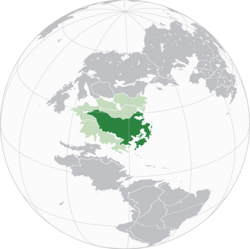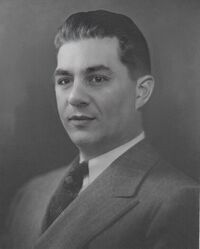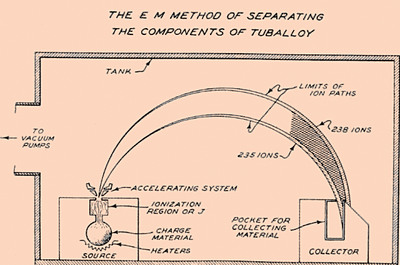Nuclear weapons and the Federated Fire Territories: Difference between revisions
Deskjetser (talk | contribs) No edit summary |
Deskjetser (talk | contribs) No edit summary |
||
| Line 27: | Line 27: | ||
[[File:Tafari_Desta.jpg|thumb|left|200px|Fyrish physicist Eadgar Tafari Desta as he appeared in a 1941 newspaper column regarding his lobbying efforts.]]With the steady stream of scientific publications regarding nuclear fission abruptly tailing off with the start of the [[Pan-Septentrion War]], Fyrish physicist [[Eadgar Tafari Desta]] promptly took it upon himself to raise concern over the fact, as he suspected a conspiracy by the Entente powers to develop a "superweapon". Strong lobbying efforts by Fyrish physicists and scientists, lead by Eadgar Tafari Desta at the start of 1940, managed to convince the government to setup an assessment programme by 1943, which was to address the "uranium issue", {{wpl|Isotope separation}}, and investigate the possibility of a chain reaction weapon. | [[File:Tafari_Desta.jpg|thumb|left|200px|Fyrish physicist Eadgar Tafari Desta as he appeared in a 1941 newspaper column regarding his lobbying efforts.]]With the steady stream of scientific publications regarding nuclear fission abruptly tailing off with the start of the [[Pan-Septentrion War]], Fyrish physicist [[Eadgar Tafari Desta]] promptly took it upon himself to raise concern over the fact, as he suspected a conspiracy by the Entente powers to develop a "superweapon". Strong lobbying efforts by Fyrish physicists and scientists, lead by Eadgar Tafari Desta at the start of 1940, managed to convince the government to setup an assessment programme by 1943, which was to address the "uranium issue", {{wpl|Isotope separation}}, and investigate the possibility of a chain reaction weapon. | ||
Early efforts centered around the issue of isotope seperation, as the properties of {{wpl|Uranium-235}} (U-235) regarding its tendancy to release two neutrons when undergoing fission, were | Early efforts centered around the issue of isotope seperation, as the properties of {{wpl|Uranium-235}} (U-235) regarding its tendancy to release two neutrons when undergoing fission, were theorised since 1935, which made it a prime candidate for a chain reaction. The primary issue with U-235, was although it was naturally occuring, the abundance of U-235 in natural uranium was known to be approximately 0.7%, whilst being chemically identical to the main constituent of natural uranium, which was U-238; Isotope-238 was known to be fissionable but not fissile, which made it incapable of supporting the slow neutron chain reaction bomb concept. With no progress being made on the seperative work process by 1945, due to the programme's strictly assessment nature, sufficient quantities of uranium isotopes were never made available to the assessment programme, which were required in order to conduct tests to ascertain data as to the true nature of a chain reaction bomb. | ||
The situation changed dramatically when the Federated Fire Territories learned of the atomic bombings of Dongrŭng and Anchŏn in 1945. Immediately after the atomic bombing, the assessment programme was moved to live project status under the codename ''Fenix'', and given top priority to national defence. From this point, the work on the programme was carried out quickly, resulting in the first {{wpl|Nuclear_reactor|nuclear reactor}} being constructed near [[Britræᵹ]] on {{Start date|1946|02|05}}. | The situation changed dramatically when the Federated Fire Territories learned of the atomic bombings of Dongrŭng and Anchŏn in 1945. Immediately after the atomic bombing, the assessment programme was moved to live project status under the codename ''Fenix'', and given top priority to national defence. From this point, the work on the programme was carried out quickly, resulting in the first {{wpl|Nuclear_reactor|nuclear reactor}} being constructed near [[Britræᵹ]] on {{Start date|1946|02|05}}. | ||
===Industrial enrichment=== | ===Industrial enrichment=== | ||
[[File:Oswald Uhtric.jpg|thumb|right|200px|Fyrish theoretical physicist Oswald Uhtric.]]Although the Britræᵹ nuclear pile was completed by the start of 1946, sufficient quantities of enriched uranium were still unavailable for weapons development, and the pile was far smaller than ideal. The Britræᵹ pile's primary purpose was to produce {{wpl|Plutonium-239}}, | [[File:Oswald Uhtric.jpg|thumb|right|200px|Fyrish theoretical physicist Oswald Uhtric.]]Although the Britræᵹ nuclear pile was completed by the start of 1946, sufficient quantities of enriched uranium were still unavailable for weapons development, and the pile was far smaller than ideal. The Britræᵹ pile's primary purpose was to produce {{wpl|Plutonium-239}} from natural uranium, 10 μg of which had been produced via {{wpl|Cyclotron|cyclotron}}, a recent [[Casaterra|Casaterran]] invention, previously under the assessment programme, and was discovered to have 1.7 times the {{wpl|Neutron_temperature#Thermal|thermal neutron}} capture cross section of uranium-235. The assessment programme panel presented these findings to Fyrish physicist Eadgar Tafari Desta towards the end of 1944, who then discussed with theoretical physicist Oswald Uhtric, how plutonium might be produced in a nuclear reactor. Desta submitted his report in December of the same year, which suggested the construction of a nuclear pile. | ||
Continually bottlenecking the program however, was the lack of industrial capacity for the seperation of uranium isotopes, which was an issue that persisted through to 1947. Not until {{ | [[File:Diagram of uranium isotope separation in the calutron.png|thumb|left|400px|Diagram of uranium isotope separation in the calutron.]]Continually bottlenecking the program however, was the lack of industrial capacity for the seperation of uranium isotopes, which was an issue that persisted through to 1947; currently a process known as {{wpl|Enriched_uranium#Thermal_diffusion|thermal diffusion}} was providing the program with uranium enriched to almost 2% in its entirety, with only one small research facility in operation at the time. Not until May 20th 1947, was further headway made into the process, when the ''Lārhūs of Fæstēah'' (LoF)<ref>''Lārhūs of Fæstēah'' translates as the ''University of Fæstēah''</ref> institute for atomic research, managed to successfully modify a cyclotron to overcome the {{wpl|Space charge|space charge}} limitation; researchers had suspected that air molecules in the vacuum chamber would neutralise the ions, and create a focused beam to be separated into a collector. This modified {{wpl|Mass spectrometry|mass spectrometer}}, coined {{wpl|Calutron|calutron}} in Casaterran circles, proved capable of performing isotope separation far more effectively than previous attempts, such as the trials by the ''Lārhūs of Britræᵹ'' (LoB) institute for atomic research's attempts using a {{wpl|Klystron|klystron}}. When the LoB calutron was first operated on May 20th, a uranium beam intensity of 5 {{wpl|Ampere|microamperes}} (μA) was received by the collector, thus proving the researchers correct about the effect air molecules had in the vacuum chamber. Later improvements led to a twelve-hour run on June 30th, with a 50 μA beam producing 24 μg of uranium enriched to 25% uranium-235, which was about ten times as much as the klystron at LoB had produced; by August, further improvements in technique refinement allowed it to generate a 1,500 μA beam, with 80 μg samples enriched to 30% being sent to project ''Fenix's'' team in the same month. Now in combination with the existing thermal diffusion process, the calutron process was able to enrich uranium from its natural 0.7% concentration of U-235, to the highest enrichment yet seen in Fyrland, upto 67% enrichement. | ||
==Notes== | ==Notes== | ||
<references /> | <references /> | ||
Revision as of 06:36, 4 February 2020
This article is incomplete because it is pending further input from participants, or it is a work-in-progress by one author. Please comment on this article's talk page to share your input, comments and questions. Note: To contribute to this article, you may need to seek help from the author(s) of this page. |
| Federated Fire Territories | |
|---|---|
 | |
| Nuclear program start date | 1945 |
| NPT party | Signatory of STAPNA |
The Federated Fire Territories commonly known as Fyrland, was the # country after New Tyran and Sieuxerr to develop and test nuclear weapons, and is one of the signatories to the STAPNA agreement.
Although the Fyrish scientific community was aware of global discourse on the feasibility of an atomic bomb throughout the 1930s, plans to develop such a weapon existed only in passing proposals by 1940, and an assessment programme was only initiated by 1943; the assessment programme was initiated due to the conspicuous lack of scientific publications regarding the study of nuclear fission, by Anglian, Glasic, and Sieuxerrian scientists, as Fyrish physicists suspected that the Entente powers had secretly begun development of a "superweapon".
No practical effort was made to pursue the programme, until the aftermath of the first use of atomic weaponry on Dongrŭng and Anchŏn in Menghe on November 9, 1945, which gave the impetus to fully initiate a nuclear weapons programme, codenamed Fenix.[1]
Early efforts
Accelerating feasibility
With the steady stream of scientific publications regarding nuclear fission abruptly tailing off with the start of the Pan-Septentrion War, Fyrish physicist Eadgar Tafari Desta promptly took it upon himself to raise concern over the fact, as he suspected a conspiracy by the Entente powers to develop a "superweapon". Strong lobbying efforts by Fyrish physicists and scientists, lead by Eadgar Tafari Desta at the start of 1940, managed to convince the government to setup an assessment programme by 1943, which was to address the "uranium issue", Isotope separation, and investigate the possibility of a chain reaction weapon.
Early efforts centered around the issue of isotope seperation, as the properties of Uranium-235 (U-235) regarding its tendancy to release two neutrons when undergoing fission, were theorised since 1935, which made it a prime candidate for a chain reaction. The primary issue with U-235, was although it was naturally occuring, the abundance of U-235 in natural uranium was known to be approximately 0.7%, whilst being chemically identical to the main constituent of natural uranium, which was U-238; Isotope-238 was known to be fissionable but not fissile, which made it incapable of supporting the slow neutron chain reaction bomb concept. With no progress being made on the seperative work process by 1945, due to the programme's strictly assessment nature, sufficient quantities of uranium isotopes were never made available to the assessment programme, which were required in order to conduct tests to ascertain data as to the true nature of a chain reaction bomb.
The situation changed dramatically when the Federated Fire Territories learned of the atomic bombings of Dongrŭng and Anchŏn in 1945. Immediately after the atomic bombing, the assessment programme was moved to live project status under the codename Fenix, and given top priority to national defence. From this point, the work on the programme was carried out quickly, resulting in the first nuclear reactor being constructed near Britræᵹ on February 5, 1946.
Industrial enrichment
Although the Britræᵹ nuclear pile was completed by the start of 1946, sufficient quantities of enriched uranium were still unavailable for weapons development, and the pile was far smaller than ideal. The Britræᵹ pile's primary purpose was to produce Plutonium-239 from natural uranium, 10 μg of which had been produced via cyclotron, a recent Casaterran invention, previously under the assessment programme, and was discovered to have 1.7 times the thermal neutron capture cross section of uranium-235. The assessment programme panel presented these findings to Fyrish physicist Eadgar Tafari Desta towards the end of 1944, who then discussed with theoretical physicist Oswald Uhtric, how plutonium might be produced in a nuclear reactor. Desta submitted his report in December of the same year, which suggested the construction of a nuclear pile.
Continually bottlenecking the program however, was the lack of industrial capacity for the seperation of uranium isotopes, which was an issue that persisted through to 1947; currently a process known as thermal diffusion was providing the program with uranium enriched to almost 2% in its entirety, with only one small research facility in operation at the time. Not until May 20th 1947, was further headway made into the process, when the Lārhūs of Fæstēah (LoF)[2] institute for atomic research, managed to successfully modify a cyclotron to overcome the space charge limitation; researchers had suspected that air molecules in the vacuum chamber would neutralise the ions, and create a focused beam to be separated into a collector. This modified mass spectrometer, coined calutron in Casaterran circles, proved capable of performing isotope separation far more effectively than previous attempts, such as the trials by the Lārhūs of Britræᵹ (LoB) institute for atomic research's attempts using a klystron. When the LoB calutron was first operated on May 20th, a uranium beam intensity of 5 microamperes (μA) was received by the collector, thus proving the researchers correct about the effect air molecules had in the vacuum chamber. Later improvements led to a twelve-hour run on June 30th, with a 50 μA beam producing 24 μg of uranium enriched to 25% uranium-235, which was about ten times as much as the klystron at LoB had produced; by August, further improvements in technique refinement allowed it to generate a 1,500 μA beam, with 80 μg samples enriched to 30% being sent to project Fenix's team in the same month. Now in combination with the existing thermal diffusion process, the calutron process was able to enrich uranium from its natural 0.7% concentration of U-235, to the highest enrichment yet seen in Fyrland, upto 67% enrichement.


